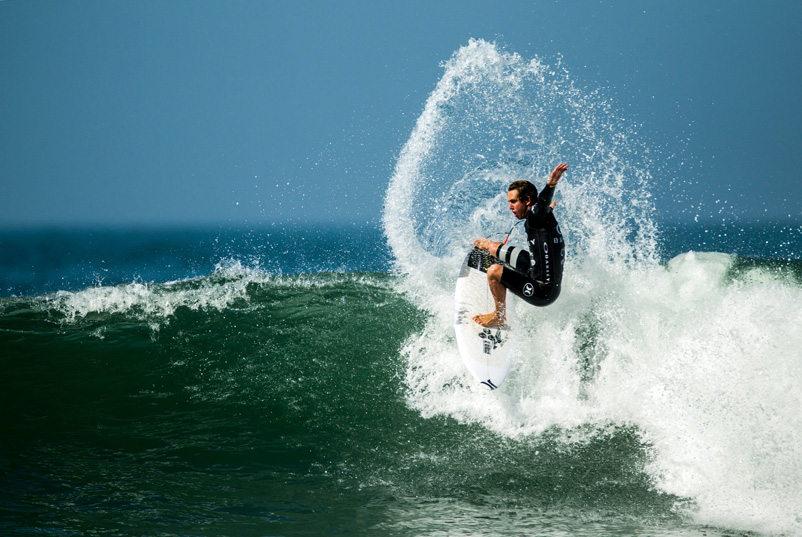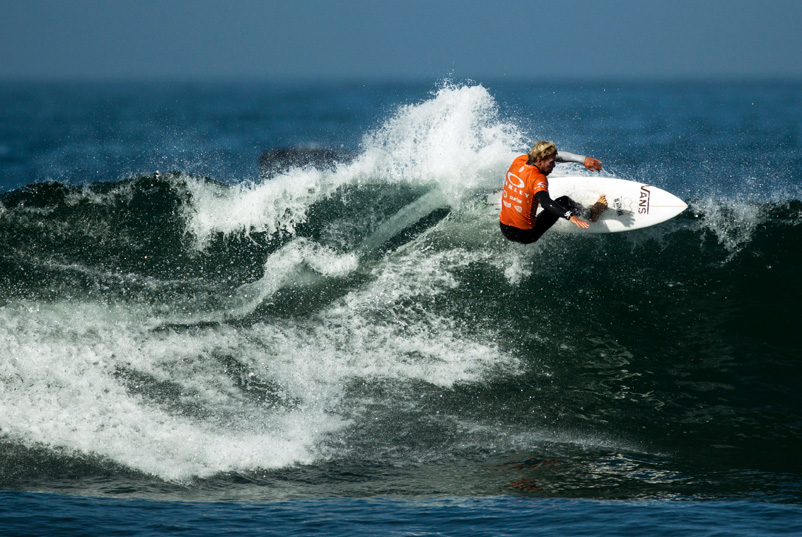The Price of Qualifying
Words by Jake Howard | Photos by Noah Garrett So, you want to be a pro surfer? Prepare to be broke. No joke. For those with aspirations of carving their way up the WQS ratings and joining the WSL World Tour, financial stability will not be an occupational hazard. The truth is in the numbers. The average ‘QS warrior can expect to pay an estimated $40,000 to $50,000 to compete in all nine of the QS 10,000 events this year, as well as select QS 6,000 contests. How do we know that? Math, my friend! Figure that airfare, car rental and room and board for two weeks during a given waiting period will total somewhere between $4,000 and $5,000. That means just to do the nine QS 10,000’s you’re looking at somewhere between $36,000-$45,000. Throw a few more stops into the mix, and the random surf trip or strike mission, and you’re over $50,000 in travel costs real quick. Then there’s the cost of equipment. While Kolohe Andino, Mick Fanning, Jordy Smith and first tier guys enjoy a garage full of free boards, most of those on the ‘QS, especially down among the lower ranks, are paying for their boards. They may be paying cost for them, but that’s still about $300-$350 a pop. That puts a quiver of six boards at about $2,000. A lot of the world tour surfers will ride 50-plus boards a year. A ‘QS grinder may only go through 20 or 30 boards. A quiver of 30 boards at $300 each is going to add up to $9,000—not exactly small change. If you don’t want to be homeless on the rare occasions you do return home from the road you’ll probably want to keep a small apartment (that you’ll barely live in). And if you want certain other amenities, like a car (that you’ll barely drive), expect to pay for registration, upkeep and insurance. Bills on the home front can add up to $10,000 a year or more. Throw in another $10,000 a year for incidentals, health and travel insurance, coaching, alcohol, and the like, and you’re looking at a grand total of about $80,000 to chase points on the WQS for one year. By comparison, it will cost an undergraduate student about $60,000 to attend Harvard University for a year…and they’ll actually have life skills after four years. “I was staying with Dunphy and had this dedicated groveller Q board, so I put the Q on the top and Dunphy on the bottom,” says Kolohe Andino of his AOS-winning raft. “Afterwards I texted him and said “I can’t believe that I won the Oz Open on a board with your name on it!” Because he’s the Q’s animal spirit? (Laughing) “Yeah kinda, it was a little bit like that. Just giving him respect!” So lets look at what we’re getting for that $80,000 investment. First, understand that there’s John John money, then there’s the rest of the herd. Most guys in the middle of the ‘QS pack that have stickers on the noses of their boards are looking at making approximately $50,000/year after all their incentives and bonuses play out. That’s about as much as a personal trainer makes for a year’s worth of lounging around a gym in the San Clemente. As noted, this doesn’t include the guys on the world tour; they have another level of earning power. There are second and third level sponsorship deals that supplement the warriors, but somebody like an eyewear sponsor will probably only pay out between $500 and $1,000 a month, or $6,000 to $12,000 a year. Of course, all of this is based on the vagary of “marketability.” For example, Conner Coffin may not be sitting as high in the ‘QS ratings, but he makes a pile more than Wade Carmichael does. Some survive on prize money alone, which is gnarly. Ask Brazilian David Do Carmo. That plan of attack means grinding it out from stop to stop, praying on a big result at each event to keep moving around the Monopoloy board that is the ‘QS schedule. In Appendix A of the official WSL rulebook they document and standardize the prize money for a world tour event, but there is no mention of the WQS. The Oakley Lowers Pro and Quiksilver Pro Saquarema both held $250,000 prize purses with $40,000 going to the winner. Safe to say that win at Saquarema made Alex Ribeiro’s year. Meanwhile, Perth Standlick, who’s sitting 96th on the tour has made $3,200 this year. Hypothetically speaking, say you’re rolling, clearing $60,000 in sponsorship money, and you do well in a handful of events, earning another $30,000 in prize money. That puts you clearing $90,000 for the year. If you live in the U.S. you can knock about a third of that off the top for taxes. Congratulations, you’ve just earned $67,000 this year. Not a bad haul…oh, but you’re saddled with $80,000 in expenses for traversing the world and “living the dream.” Now you’re in the hole $13,000. Now what do you do? “I personally look at it as an opportunity to travel the world for a year and I don’t have to work a nine-to-five to save the money to do it,” says an eager young Cooper Chapman. “I get to do something a love and chase a dream of being a world champion. My friends at home work every day to save to travel. I get to go surf, meet amazing people and see the world. I mightn’t end the year with any money in my pocket, but you can’t value life in money.” Tanner Gudauskas is a gent whose surfing surely belongs on the world tour, but who seems cursed to forever hover on the edge of qualification, tasting brief teasers of the brightest light from time to time.
Words by Jake Howard | Photos by Noah Garrett
So, you want to be a pro surfer? Prepare to be broke. No joke. For those with aspirations of carving their way up the WQS ratings and joining the WSL World Tour, financial stability will not be an occupational hazard.
The truth is in the numbers. The average ‘QS warrior can expect to pay an estimated $40,000 to $50,000 to compete in all nine of the QS 10,000 events this year, as well as select QS 6,000 contests. How do we know that? Math, my friend! Figure that airfare, car rental and room and board for two weeks during a given waiting period will total somewhere between $4,000 and $5,000. That means just to do the nine QS 10,000’s you’re looking at somewhere between $36,000-$45,000. Throw a few more stops into the mix, and the random surf trip or strike mission, and you’re over $50,000 in travel costs real quick.
Then there’s the cost of equipment. While Kolohe Andino, Mick Fanning, Jordy Smith and first tier guys enjoy a garage full of free boards, most of those on the ‘QS, especially down among the lower ranks, are paying for their boards. They may be paying cost for them, but that’s still about $300-$350 a pop. That puts a quiver of six boards at about $2,000. A lot of the world tour surfers will ride 50-plus boards a year. A ‘QS grinder may only go through 20 or 30 boards. A quiver of 30 boards at $300 each is going to add up to $9,000—not exactly small change.
If you don’t want to be homeless on the rare occasions you do return home from the road you’ll probably want to keep a small apartment (that you’ll barely live in). And if you want certain other amenities, like a car (that you’ll barely drive), expect to pay for registration, upkeep and insurance. Bills on the home front can add up to $10,000 a year or more.
Throw in another $10,000 a year for incidentals, health and travel insurance, coaching, alcohol, and the like, and you’re looking at a grand total of about $80,000 to chase points on the WQS for one year. By comparison, it will cost an undergraduate student about $60,000 to attend Harvard University for a year…and they’ll actually have life skills after four years.

“I was staying with Dunphy and had this dedicated groveller Q board, so I put the Q on the top and Dunphy on the bottom,” says Kolohe Andino of his AOS-winning raft. “Afterwards I texted him and said “I can’t believe that I won the Oz Open on a board with your name on it!” Because he’s the Q’s animal spirit? (Laughing) “Yeah kinda, it was a little bit like that. Just giving him respect!”
So lets look at what we’re getting for that $80,000 investment. First, understand that there’s John John money, then there’s the rest of the herd. Most guys in the middle of the ‘QS pack that have stickers on the noses of their boards are looking at making approximately $50,000/year after all their incentives and bonuses play out. That’s about as much as a personal trainer makes for a year’s worth of lounging around a gym in the San Clemente. As noted, this doesn’t include the guys on the world tour; they have another level of earning power. There are second and third level sponsorship deals that supplement the warriors, but somebody like an eyewear sponsor will probably only pay out between $500 and $1,000 a month, or $6,000 to $12,000 a year. Of course, all of this is based on the vagary of “marketability.” For example, Conner Coffin may not be sitting as high in the ‘QS ratings, but he makes a pile more than Wade Carmichael does.
Some survive on prize money alone, which is gnarly. Ask Brazilian David Do Carmo. That plan of attack means grinding it out from stop to stop, praying on a big result at each event to keep moving around the Monopoloy board that is the ‘QS schedule. In Appendix A of the official WSL rulebook they document and standardize the prize money for a world tour event, but there is no mention of the WQS. The Oakley Lowers Pro and Quiksilver Pro Saquarema both held $250,000 prize purses with $40,000 going to the winner. Safe to say that win at Saquarema made Alex Ribeiro’s year. Meanwhile, Perth Standlick, who’s sitting 96th on the tour has made $3,200 this year.
Hypothetically speaking, say you’re rolling, clearing $60,000 in sponsorship money, and you do well in a handful of events, earning another $30,000 in prize money. That puts you clearing $90,000 for the year. If you live in the U.S. you can knock about a third of that off the top for taxes. Congratulations, you’ve just earned $67,000 this year. Not a bad haul…oh, but you’re saddled with $80,000 in expenses for traversing the world and “living the dream.” Now you’re in the hole $13,000. Now what do you do?
“I personally look at it as an opportunity to travel the world for a year and I don’t have to work a nine-to-five to save the money to do it,” says an eager young Cooper Chapman. “I get to do something a love and chase a dream of being a world champion. My friends at home work every day to save to travel. I get to go surf, meet amazing people and see the world. I mightn’t end the year with any money in my pocket, but you can’t value life in money.”
Tanner Gudauskas is a gent whose surfing surely belongs on the world tour, but who seems cursed to forever hover on the edge of qualification, tasting brief teasers of the brightest light from time to time.















Comments
Comments are a Stab Premium feature. Gotta join to talk shop.
Already a member? Sign In
Want to join? Sign Up